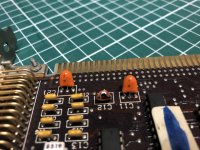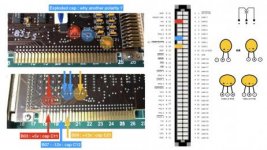RetroSpector78
Experienced Member
I have a 286 that came with 2 bad caps close to the PSU (2 10mF 16V caps that needed replacing. One was completely blown and another damaged. One was short circuit and the other open circuit).
I replaced those 2 caps and the machine booted fine .....
But when I inserted an I/O card in an ISA slot, I noticed that the PC did not start (not even the PSU fan would start).
When I removed the I/O card the PC would boot fine again.
So I started poking around the I/O card and noticed a capacitor that was short circuit. This capacitor was hooked up to the -12V rail, and caused the -12V to short to GND. Not good.
I wanted to verify my claims that this was causing the PC not to start, so I inserted the I/O card back in the PC and started the PC. Only this time the capacitor exploded on my I/O card , and the PC was starting. (I guess the explosion of the cap removed the short).
Now, I inserted a different type of I/O card in the PC (an IBM serial / parallel card), thinking the previous issue was caused by the I/O card and not the computer but guess what .... again a capacitor blew, this time on the IBM card. I believe the cap that exploded is again linked to the -12V rail.
Now, I don't really feel like blowing up any more cards (thank god its bedtime), but I wanted to check with you guys if you think I just had bad luck with 2 I/O cards that had bad caps. Or if something else is at play (perhaps the PC is causing all of this).
Any tips on how to further diagnose this ?
The PC is booting now with the cards, and the AMI bios boot screen seems to detect the serial / parallel ports on it, although I tried to setup an LPT interlnk/intersvr session and that failed (perhaps related to the blown cap).
Thx
I replaced those 2 caps and the machine booted fine .....
But when I inserted an I/O card in an ISA slot, I noticed that the PC did not start (not even the PSU fan would start).
When I removed the I/O card the PC would boot fine again.
So I started poking around the I/O card and noticed a capacitor that was short circuit. This capacitor was hooked up to the -12V rail, and caused the -12V to short to GND. Not good.
I wanted to verify my claims that this was causing the PC not to start, so I inserted the I/O card back in the PC and started the PC. Only this time the capacitor exploded on my I/O card , and the PC was starting. (I guess the explosion of the cap removed the short).
Now, I inserted a different type of I/O card in the PC (an IBM serial / parallel card), thinking the previous issue was caused by the I/O card and not the computer but guess what .... again a capacitor blew, this time on the IBM card. I believe the cap that exploded is again linked to the -12V rail.
Now, I don't really feel like blowing up any more cards (thank god its bedtime), but I wanted to check with you guys if you think I just had bad luck with 2 I/O cards that had bad caps. Or if something else is at play (perhaps the PC is causing all of this).
Any tips on how to further diagnose this ?
The PC is booting now with the cards, and the AMI bios boot screen seems to detect the serial / parallel ports on it, although I tried to setup an LPT interlnk/intersvr session and that failed (perhaps related to the blown cap).
Thx



